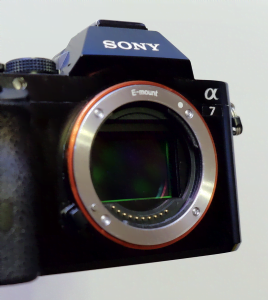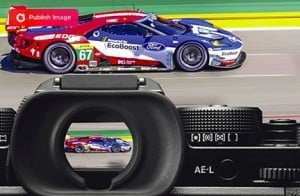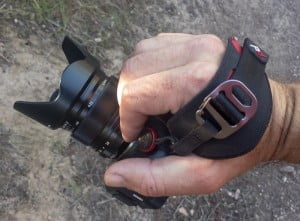Disclosure: This post may contain affiliate links. I earn a small commission of product sales to keep this website going.
I’ve been loving the contributions that mirrorless cameras have made to my photography evolution and my capabilities as a minimalist backpacker & traveler. They have many advantages to a lightweight traveler, but there are also a few important disadvantages of mirrorless cameras.
Will these disadvantages put you off from a mirrorless camera? Keep reading for a breakdown of what I think are the most important things to consider when going mirrorless. These are mostly aimed at the traveler and outdoor enthusiast.
Related:
Sensor exposure
When you change the lens on a DSLR, the sensor is mostly protected by that mirror that sits right in front of it. Dust can still get into the camera housing when you change lenses, but floaties in the air are less likely to land on the sensor.
When you change the lens on a mirrorless camera, bam, the precious, delicate sensor is vulnerable to the world, right there in front. This is one of the most expensive disadvantages of mirrorless cameras.

I’ve made a quick lens change only to find a black stripe in the middle of my electronic viewfinder. It was a tiny little piece of threading or something that had found its way to the middle of the sensor in those few seconds it was exposed to the air. A quick blast with a rocket blower cleared it out, but it was still a bit of a scare. Even worse can happen if you’re not careful.
A backpacking & travel photographer can mitigate this disadvantage by turning their back to the wind during a lens change and remember the following:
- Make sure the lenses are ready to swipe out before removing the lens from the camera.
- Have the air blower ready to blow out any dust right before the change.
- Activate the sensor cleaning function on your camera, where a quick vibration will knock most loose dust off of the sensor.
Electronic viewfinder limitations

Electronic viewfinder capabilities have come a long way in the past few years and will only continue to improve over the next few. Still, this is one of the disadvantages of mirrorless cameras that keeps DSLR enthusiasts from jumping aboard the mirrorless train.
When you look through the viewfinder of a DSLR, the prism and mirror show you exactly the light that’s reaching the front of the lens at that exact moment in time. There are no tricks. You’re just looking through the lens.
The electronic viewfinder (EVF) of a mirrorless camera shows you what’s happening after the light goes through the sensor and processor. This has some wonderful advantages, but also some disadvantages:
- Slight loss of clarity due to limitations of pixel density. Between the Fujifilm X-T2 and X-H1, the EVF resolution increased from 2.36 million dots to 3.69 million. Sony’s new OLED EVF, not yet in any camera, boasts 5.6 million dots.
- Processor lag means that what you’re seeing in the EVF isn’t what’s happening at this exact same instant. However, the display time lag of the X-T2 and X-H1, for example, is only .005 seconds, so I’d challenge you to notice that difference.
- Along with processor lag, you’re also dealing with display refresh rates. This too is continuing to improve, with an increase from 60fps to 100fps between the X-T2 and X-H1. Sony’s new EVF has a refresh rate of 240fps – nearly fluid.
- EVFs are limited in low light just as the sensor is. You’ll notice grain, lose clarity, and have lower refresh rates. Today’s low-light sensors are reducing this limitation.
Battery life
Battery life is yet another one of the disadvantages of mirrorless cameras that’s slowly closing in on DSLRs.
All of that EVF processing happening in the section above really uses up the juice. You’ll have to carry extra batteries or charging solutions on extended outings.
The original Sony a7 had a CIPA standard battery life of 270 shots with the EVF and 340 with the LCD. The Canon 5D Mark II DSLR’s battery could get you through 850 shots using the optical viewfinder. The Sony a9 currently has one of the best mirrorless battery capacities of 480 shots with the EVF and 650 with the LCD. Expect this to continue to improve.
You can extend the battery life of mirrorless cameras using the tricks I outline in Extending Mirrorless Camera Battery Life On The Trail.
Ergonomics
We love mirrorless cameras because they’re small.
The small size, however, doesn’t fit well in large hands. Holding the small grip for extended periods might cause your hands to cramp up. This is a disadvantage of mirrorless cameras that we’ll always be dealing with.
I’ve never had a problem with cramping, however, and I quickly became accustomed to the tighter arrangement of controls.
Extended hand grips are available for most mirrorless cameras. I also use the Peak Design Hand Clutch to give my hand a grip break when I’m not actively shooting – this reduces a lot of hand fatigue.

Lens selection
Mirrorless camera lens mounts are extremely new compared to the Canon EF/EF-S and Nikon FX/DX lens mounts that have been out for decades.
Sony originally had about 10 lenses when the a7 and a6000 were released, but they now offer in the neighborhood of 40 lenses.
Third-party manufacturers are also producing mirrorless lenses just like they do for DSLRs.
It shouldn’t be long before photographers have all of the lenses they need for mirrorless cameras.
Most travel photographers already have what they need with a selection of fast zoom lenses.
Will these disadvantages of mirrorless cameras be a deal-breaker for you?
Further reading: Advantages of mirrorless cameras vs. DSLRs, Mirrorless Camera Photography Tips

Building your Fujifilm Photography Kit Part 3: Essential Accessories - DIY Photography
Tuesday 1st of March 2022
[…] of the disadvantages of mirrorless cameras is that they suck the battery down much faster than […]
Dale Williams
Saturday 15th of January 2022
I've tried shooting with the mirrorless. But just like Kobe Bryant says he loves the squeaking of the sneakers on the court, I love the weight and the sound of the shutter. I shoot sports and models. I can "feel the shot" more with a DSLR ( I shoot with the 1DX) more so than a mirrorless. I just wish camera manufacturers would keep their line of DSLRS for those that like shooting with them. Can both cameras coexist together in the market?
John Peltier
Monday 17th of January 2022
Yeah I definitely think they can coexist, but unfortunately the camera manufacturers have other motivations for producing the cameras that they do.
Kenapa harus Beralih Ke Kamera Mirrorless? 2021
Thursday 9th of September 2021
[…] Counter opinion to : https://www.jmpeltier.com/disadvantages-of-mirrorless-cameras/ […]
cak bass
Wednesday 8th of September 2021
When you wrote this article on 2019, I think some of your opinion has been left behind. I think, since 2018 they are growth and bombardier some new models with very good improvement.
John Peltier
Wednesday 8th of September 2021
They have made some good improvements, but overall I think still fall behind in some of these categories. With that said, I've been a mirrorless user for six years now and absolutely love them!
Pascal
Thursday 27th of May 2021
Shutter shock in manual mode at low speed, rolling shutter, banding... so many other problems with mirrorless!
John Peltier
Thursday 27th of May 2021
Those aren't problems with mirrorless cameras specifically. DSLRs have these problems too. In both cases they're only "problems" because the photographer chooses the wrong setting/setup for the situation.